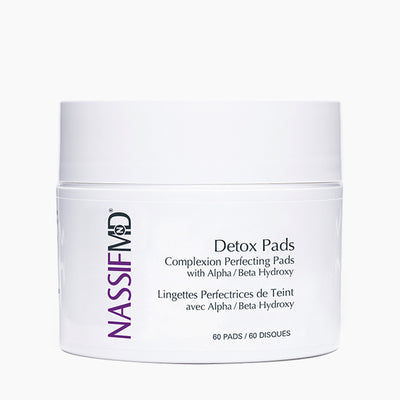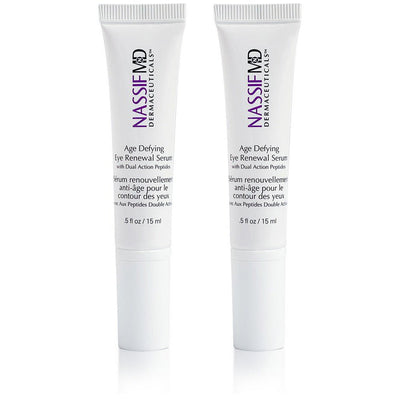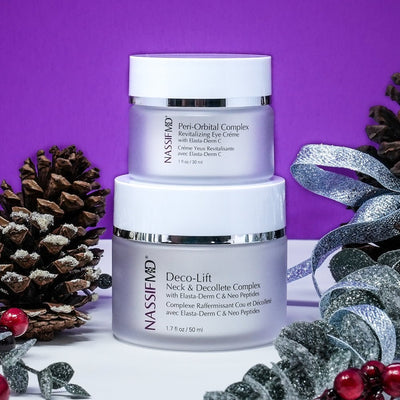Makeup or Sunscreen First? Your FAQs Answered (2024 Update)
Regular sunscreen use is critical for protecting the skin from premature aging and skin cancer, but the rest of your skincare routine is important, too. Using sunscreen correctly can help enhance the effectiveness of your routine and provide sun protection.
You might have an advanced skincare routine or a more streamlined approach; either way, you’ll need to know where your SPF goes in the order of application. We all know why sunscreen is important, but let’s get into how to use sunscreen, especially when you wear makeup. Keep reading as we answer the FAQs about layering sunscreen with makeup, including:
- When to apply sunscreen in your skincare routine?
- Does sunscreen go before or after moisturizer?
- Do you put moisturizer on before primer?
- Do you put sunscreen on before or after makeup?
- Why does my sunscreen pill?
- What SPF sunscreen is best?
- What to avoid in sunscreen?
- How often should you reapply sunscreen?
- Should you wear sunscreen inside?
- Does sunscreen prevent wrinkles?
- Is foundation with SPF enough?
- What is the best sunscreen for your face?
When Should You Apply Sunscreen in Your Skincare Routine?
When wearing sunscreen and makeup, the simple answer is this: apply sunscreen after skincare and before makeup. With this strategy, you’ll get the most from the active ingredients in your skincare products (including NassifMD® facial plastic surgeon skincare) and get the best barrier protection from your sunscreen. Let’s explore some of the details next.
Does Sunscreen Go on Before or After Moisturizer?
Deciding to use SPF before or after moisturizer is one of the hottest FAQs on this topic. We recommend using sunscreen after moisturizer for the best protection from sun exposure. Often, moisturizer is the last step of your skincare routine, so the order goes moisturizer, sunscreen, and then makeup.
The next question often arises is whether to use moisturizer or primer first.
If you also use a makeup primer (a product that prepares the skin for makeup), consider the primer the first step of your makeup routine and not the last step of your skincare routine. The order would be moisturizer, sunscreen, and then primer.
Do You Put Sunscreen on Before or After Makeup?
Wear sunscreen under makeup. Put it on first, allowing the sunscreen to dry thoroughly before beginning your makeup routine. Makeup doesn’t interfere with the sunscreen’s benefits and may enhance them.
One study suggests makeup provides another barrier to protect the skin from the sun and may enhance its benefits. In cases where someone doesn’t use enough sunscreen (which is common), makeup helps compensate for the insufficiency by offering extra protection. However, makeup alone isn’t enough protection to skip sunscreen altogether.
How Do You Reapply Sunscreen Over Makeup?
If you apply sunscreen in the morning before makeup and are outdoors in the sun, you may need to reapply sunscreen for continued protection. If you’re on the go, reapply the sunscreen over the makeup.
Please note that the second application may not be as effective as the first because the sunscreen is over makeup instead of under it, but it will provide some protection. You can also wear a wide-brimmed hat or seek shade.
How Long Should I Wait After Applying Sunscreen Before Applying Makeup?
Apply sunscreen after your skincare routine when the last products are fully absorbed, and the face is dry. This may require waiting 3 to 5 minutes between your skincare routine and sunscreen application.
What Type of Sunscreen is Best for Layering Under Makeup: Physical or Chemical?
We always recommend physical sunscreens for all uses, including layering under makeup. Physical sunscreens are mineral-based and sit on top of the skin to reflect sunlight. Examples of physical sunscreens are zinc oxide and titanium dioxide. Physical sunscreens are non-toxic and safe for use.
Chemical sunscreens absorb into the skin and absorb UVA and UVB rays instead of deflecting them. Some chemical sunscreens are safer than others, but many compounds pose risks to human health and the environment, including coral reefs. Some chemical sunscreens, including Tinosorb S and M, are banned in the U.S. and other countries around the globe. Canada and Europe have an even longer list of banned ingredients.
NassifMD® Skincare only uses the safest, cruelty-free ingredients for your skin and our planet.
How Do I Prevent My Makeup from Pilling or Balling Up When Layered Over Sunscreen?
Sunscreen pilling refers to sunscreen that flakes off the skin under makeup. It can occur because of poor sunscreen ingredients. Another reason for pilling is not letting skincare products fully absorb before applying sunscreen. With quality NassifMD® products and the correct order of application, you can avoid pilling.
Do I Need to Use a Specific Type of Foundation or BB Cream with Sunscreen?
Continue to use your preferred skincare products over sunscreen. Let the sunscreen absorb fully first, and it shouldn’t affect your makeup routine. Apply your foundation or BB cream directly over the sunscreen.
BB cream is short for beauty balm or blemish balm, a combination of makeup foundation with skincare ingredients that’s easy to apply.
Can I Use a Moisturizer with SPF Instead of a Separate Sunscreen Under Makeup?
We are always on the lookout for products to help streamline facial routines. Moisturizers with SPF combine hydrating and moisturizing skincare ingredients with SPF (sun protection factor) protection in one formula. They might be smoother to apply than sunscreens designed for the body.
One point to remember is that it can be easy to apply too little sunscreen when it’s in a combination product. You may need to be more generous with your application for full protection. Research suggests you need 2 mg of SPF per square centimeter of skin.
This amount is about one finger length of sunscreen from the bottle for your face.
Are There Any Specific Ingredients I Should Avoid When Layering Sunscreen and Makeup?
We’ve already discussed some questionable chemical sunscreen ingredients to avoid, and quality is also essential when it comes to skincare ingredients. Most active skincare ingredients are compatible with sunscreen and may be enhanced when applied to the skin first and sealed in with sunscreen. However, for personalized guidance, please consult your dermatologist or esthetician.
In general, skincare ingredients to avoid include parabens, phthalates, mineral oil, and any ingredients you are allergic or sensitive to.
What SPF Sunscreen is Best?
SPF is a rating for the effectiveness of sunscreen and lets you know approximately how long it will provide protection. A higher SPF allows you to stay in the sun longer, but it’s important to consider your skin’s sensitivity to the sun and make sure you apply enough.
Most experts recommend using a minimum of SPF 30 protection.
What Should You Avoid in Sunscreen?
How to pick the right sunscreen depends on your skin type and preferences. Choose a quality product with nourishing, hydrating ingredients and mineral-based protection (like zinc oxide and titanium dioxide). Like skincare, avoid harmful ingredients like mineral oil and parabens in sunscreen.
All NassifMD® facial plastic surgeon skincare products are cruelty-free, gluten-free, vegan, paraben-free, and mineral-oil free.
How Often Should You Reapply Sunscreen?
When you are directly in the sun for long periods, reapply sunscreen every 2 hours. If your skin is susceptible to burning, you may need to apply it more often. If you aren’t very prone to burning, you may be able to go longer.
Should You Wear Sunscreen Inside?
When exposed to blue light from outdoors through windows, you can still experience the harmful effects of sun exposure. We recommend wearing sunscreen every day, even in the winter. Cover your face, hands, and any exposed area.
Does Sunscreen Prevent Wrinkles?
There is a significant link between sun exposure and aging. Sun damage accelerates aging by causing free radical damage, disrupting DNA, altering the immune response, and degrading collagen. Without enough antioxidants, it can be challenging for the skin to recover from constant sun exposure. Over time, wrinkles and other signs of skin aging will intensify.
Wearing sunscreen may slow aging and the associated development of wrinkles.
Is Foundation with SPF Enough?
You may be tempted to choose a foundation with SPF. However, you’ll need to lose a lot of foundation to get enough SPF protection. For most people, typical foundation application is insufficient. However, you can wear SPF foundation over sunscreen for added sun protection.
What is the Best Sunscreen For Your Face?
While foundation with SPF is insufficient, tinted sunscreen is a wonderful alternative. It provides optimal sun protection and helps streamline your skincare and makeup routine by eliminating the foundation step. Some people may prefer this lighter routine, especially in the summer.
NassifMD® Protect & Hydrate is the best sunscreen for under makeup or anytime. It provides SPF 44 from minerals (zinc oxide and titanium dioxide) and hydrating, protecting ingredients, including hyaluronic acid and vitamin C. This sunscreen is so much more than a sunscreen! It’s lightweight, waterproof, and acts like a BB cream. It also features a universal tint ideal for all skin tones.
Don’t forget your lips! For complete protection add NassifMD® Hydrating Lip Balm to your routine to hydrate, smooth, and protect the lips with mango seed butter, sunflower oil, jojoba, and SPF 15. Carry one in your purse or bag for easy application on the go.
With so many questions about makeup and sunscreen, the answers are simple: wear sunscreen daily, apply it after skincare and before makeup, and choose quality products to enhance your skincare routine and sun protection. NassifMD® Skincare’s SPF product line is a trusted source for your year-round sunscreen needs.
References
- Kim, M. A., Jung, Y. C., Bae, J., Ha, J., & Kim, E. (2021). Layering sunscreen with facial makeup enhances its sun protection factor under real-use conditions.Skin research and technology : official journal of International Society for Bioengineering and the Skin (ISBS) [and] International Society for Digital Imaging of Skin (ISDIS) [and] International Society for Skin Imaging (ISSI), 27(5), 751–757.
- Petersen, B., & Wulf, H. C. (2014). Application of sunscreen--theory and reality.Photodermatology, photoimmunology & photomedicine, 30(2-3), 96–101.
- Wang, M., Charareh, P., Lei, X., & Zhong, J. L. (2019). Autophagy: Multiple Mechanisms to Protect Skin from Ultraviolet Radiation-Driven Photoaging.Oxidative medicine and cellular longevity, 2019, 8135985.
- Guan, L. L., Lim, H. W., & Mohammad, T. F. (2021). Sunscreens and Photoaging: A Review of Current Literature.American journal of clinical dermatology, 22(6), 819–828.



































